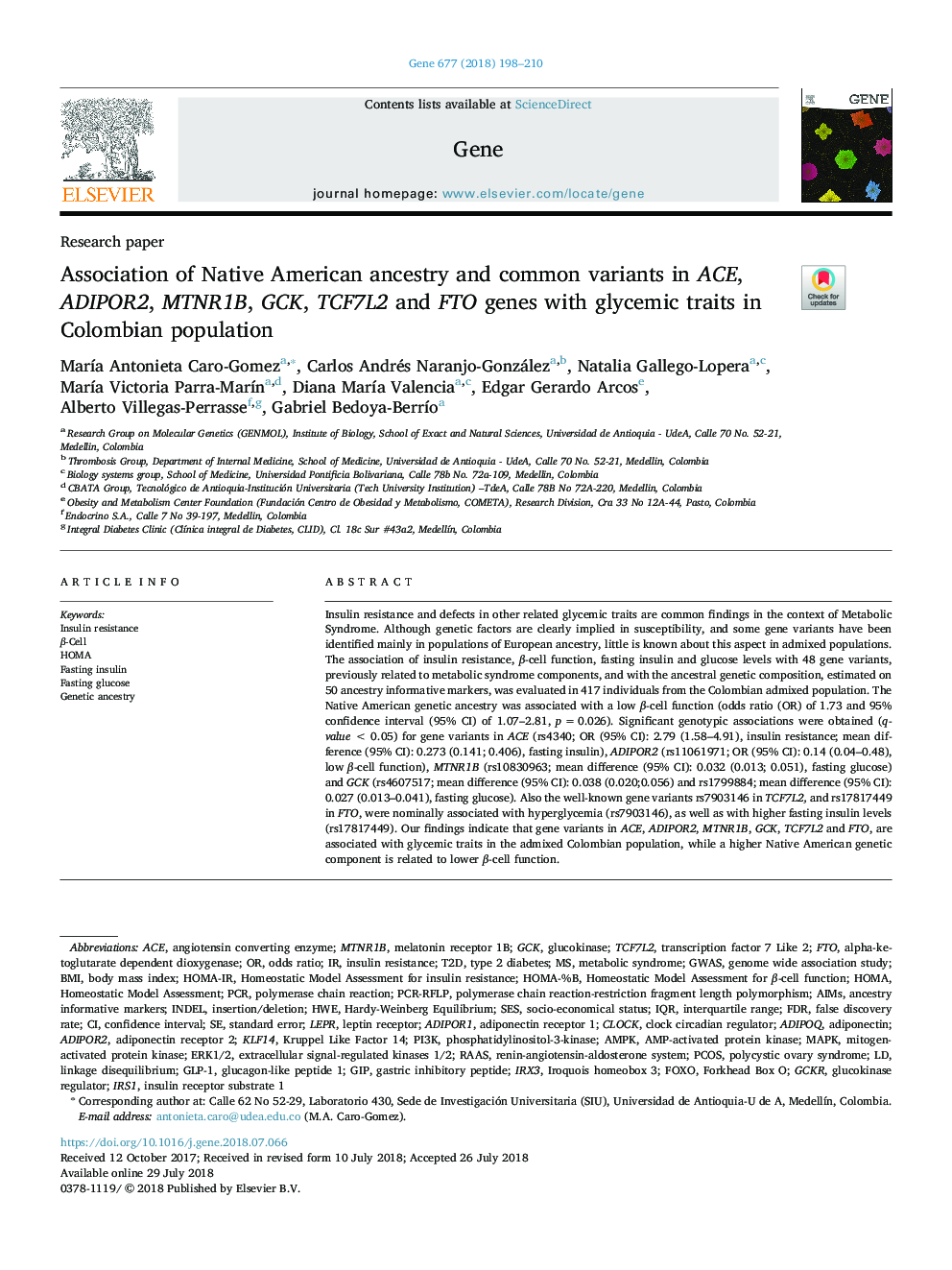| Article ID | Journal | Published Year | Pages | File Type |
|---|---|---|---|---|
| 8644419 | Gene | 2018 | 13 Pages |
Abstract
Insulin resistance and defects in other related glycemic traits are common findings in the context of Metabolic Syndrome. Although genetic factors are clearly implied in susceptibility, and some gene variants have been identified mainly in populations of European ancestry, little is known about this aspect in admixed populations. The association of insulin resistance, β-cell function, fasting insulin and glucose levels with 48 gene variants, previously related to metabolic syndrome components, and with the ancestral genetic composition, estimated on 50 ancestry informative markers, was evaluated in 417 individuals from the Colombian admixed population. The Native American genetic ancestry was associated with a low β-cell function (odds ratio (OR) of 1.73 and 95% confidence interval (95% CI) of 1.07-2.81, pâ¯=â¯0.026). Significant genotypic associations were obtained (q-valueâ¯<â¯0.05) for gene variants in ACE (rs4340; OR (95% CI): 2.79 (1.58-4.91), insulin resistance; mean difference (95% CI): 0.273 (0.141; 0.406), fasting insulin), ADIPOR2 (rs11061971; OR (95% CI): 0.14 (0.04-0.48), low β-cell function), MTNR1B (rs10830963; mean difference (95% CI): 0.032 (0.013; 0.051), fasting glucose) and GCK (rs4607517; mean difference (95% CI): 0.038 (0.020;0.056) and rs1799884; mean difference (95% CI): 0.027 (0.013-0.041), fasting glucose). Also the well-known gene variants rs7903146 in TCF7L2, and rs17817449 in FTO, were nominally associated with hyperglycemia (rs7903146), as well as with higher fasting insulin levels (rs17817449). Our findings indicate that gene variants in ACE, ADIPOR2, MTNR1B, GCK, TCF7L2 and FTO, are associated with glycemic traits in the admixed Colombian population, while a higher Native American genetic component is related to lower β-cell function.
Keywords
GCKADIPOR2ACEHWEHOMA-IRADIPOQIQRAMPKGLP-1T2DRAASGIPLEPRPCOSTCF7L2IRS1MTNR1BAdipoR1GCKRIRX3PI3KFDRInDelAMP-activated protein kinaseERK1/2MAPKβ-CelladiponectinSESangiotensin converting enzymeHomeostatic model assessmentHomeostatic model assessment for insulin resistanceFasting insulinAIMSHardy-Weinberg equilibriumforkhead Box Ostandard errorinsertion/deletionFTOType 2 diabetesPCR-RFLPinsulin receptor substrate 1ClockPolycystic ovary syndromeMetabolic syndromeRenin-angiotensin-aldosterone systembody mass indexBMILinkage disequilibriumconfidence intervalFoxOphosphatidylinositol-3-kinaseinterquartile rangegenome wide association studyGWASInsulin resistancefalse discovery rategenetic ancestryodds ratioAncestry informative markersHOMApolymerase chain reactionPCRmitogen-activated protein kinasepolymerase chain reaction-restriction fragment length polymorphismglucagon-like peptide 1Gastric inhibitory peptideExtracellular signal-regulated kinases 1/2Fasting glucoseGlucokinaseadiponectin receptor 1adiponectin receptor 2Leptin receptor
Related Topics
Life Sciences
Biochemistry, Genetics and Molecular Biology
Genetics
Authors
MarÃa Antonieta Caro-Gomez, Carlos Andrés Naranjo-González, Natalia Gallego-Lopera, MarÃa Victoria Parra-MarÃn, Diana MarÃa Valencia, Edgar Gerardo Arcos, Alberto Villegas-Perrasse, Gabriel Bedoya-BerrÃo,
